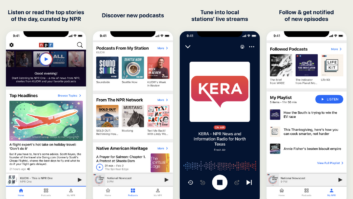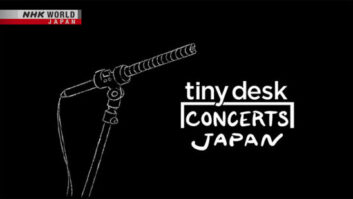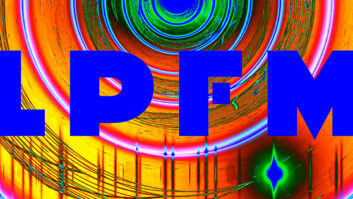
Terry Cockerill of Harris and Mike Hendrickson of Minnesota Public Radio with Harris HPX transmitter As the first portable HD Radio model hit store shelves in July, the discussion over elevated FM digital power became more urgent, and those lobbying for and against a power increase let the Federal Communications Commission know their thoughts.
IBiquity and NPR, meanwhile, offered up different, interim steps the agency could take before rendering a decision on a full, voluntary 10 dB increase.
IBiquity and Greater Media proposed an immediate, interim 6 dB increase and submitted indoor reception tests results for various digital power levels on a Greater Media Boston station to back up the request.
NPR prefers that the commission wait until NPR can deliver its latest testing results; it opposes an “arbitrary” across-the-board increase that it believes would fail to prevent new analog interference. However, should the FCC feel compelled to make a decision sooner, NPR proposed its own interim increased power approach based on distance separations and station class (see sidebar).
At the same time, NPR Labs personnel were racing to meet a self-imposed accelerated test schedule. The lab plans to have mobile field tests completed in various markets and data tabulated this month. It hopes to deliver results and recommend channel protection ratios — the foundation of an allocation policy — to the commission next month. NPR also hopes to present its test findings at the NAB Radio Show.

A Ford Focus was fitted with NPR Labs’ custom Calibrated Ground Plane Antenna, which was used to receive the over-the-air audio as well as collect field strength data. Using special instrumentation, NPR collected field strengths continuously on 88.3 MHz (KBPN-FM), 88.5 MHz (KCRB-FM) and 88.1 MHz (lower first-adjacent to KBPN). They also recorded fast (Rayleigh) fading to determine multipath levels and audio WAV files on the analog FM receiver, a Chevy Suburban unit.
As Radio World’s “The Leslie Report” first reported in July, NPR Labs had completed two-thirds of its mobile field testing and was close to beginning the final leg of that testing in a Baltimore suburb.
Rhode Island tests
“Everybody wants an answer about how to manage power in light of adjacent neighbors,” John Kean of NPR Labs said, “because we expect analog to be around for many years to come.”
The broadcaster first conducted mobile field tests in Rhode Island. Over numerous several-day periods, WKLB and WRNI conducted elevated power tests, looking at modeling field- and lab-generated mobile audio samples. Those two stations were chosen because they’re first-adjacent to each other and WKLB had received temporary high-power authorization earlier this year.
Class A WRNI is part of Rhode Island Public Radio and operates on 102.7 MHz in Providence. Class B WKLB is owned by Greater Media and operates on 102.5 MHz in Boston.
The Rhode Island tests, a story “The Leslie Report” also broke, differed from past NPR Labs tests because they involved taking mobile audio measurements to back up measurements made in the lab. WRNI and NPR Labs engineers took measurements at certain points from one van while Greater Media and iBiquity engineers followed in another and also took measurements for corroboration and redundancy on collecting the NPR audio samples.
A core working group — consisting of several commercial radio directors of engineering as well as iBiquity staff, engineers from CEA, NAB and Harris — advises the lab on its methodology for the elevated power tests. A larger peer review group of several dozen stations — both commercial and non-commercial — and industry stakeholders are reviewing and commenting on the study.
NPR’s Interim Power Boost Proposal An across-the-board HD Radio power increase would be arbitrary and fail to avoid new analog interference, NPR told the FCC in July. However: “If the commission deems it vitally necessary to authorize an interim power increase, then it should only authorize an increase that avoids additional adjacent analog interference, and adopt mileage-based power increases.”
The commission should consider distance separations and facility size in ways appropriate to the commercial and non-commercial band, the network believes. Its proposal for stations in the non-reserved band is based on minimum separation requirements according to station class.
The NPR proposal for the reserved FM band is adapted to contour protections:
- • Compute the F(50,50) 60 dBu service contour of the protected station
- • For the first-adjacent IBOC proponent’s FM carrier, determine F(50,10) field strengths (FSI) at intersections with the service contour of the protected station
- • The allowable IBOC power, in dBc, is the maximum of: –(20 dBc – 60 dBu + (IBOC station maximum analog) FSI dBu + 6 dB)
This formula determines the IBOC transmission power above the standard –20 dBc level. For example, if 47 dBu is the highest field strength of the first-adjacent IBOC proponent station at any intersection with the protected station contour, then the allowable IBOC power is: –(20 – 60 + (47 + 6)) = –13 dBc (5.0%)
The only sure way to resolve interference concerns is to avoid interference in the first place as assurances that interference can be resolved on a case-by-case basis are likely to prove elusive and expensive to implement, NPR concludes.
— Leslie Stimson
Minnesota tests
In Mid-June, NPR Labs conducted mobile field tests on two Minnesota Public Radio stations.
Harris shipped an HPX40 high-power, common-amplification transmitter to KCRB(FM), Bemidji, Minn., for the elevated power tests, which took place on three days and two nights. Engineers raised the digital power for the Minnesota Public Radio station at its transmitter site in Black Duck to –20 dB, –14 dB and –10 dB while NPR Labs took mobile field measurements from both KCRB and on so-called “victim station” KBPN(FM), Brainerd, Minn. with test gear in its measurement vehicle.
KBPN is a first-adjacent to KCRB and 75 miles to the southeast. The idea of this “pilot” test was to see how raising the IBOC transmission power on KCRB affected mobile reception of KBPN as samples of loud and soft music and male and female talk were aired.
Engineers took audio recordings and field strength measurements for each test. Kean and Jan Andrews of NPR Labs conducted the testing along with MPR engineers Mike Hendrickson and Doug Thompson. CBS Radio DOE Glynn Walden, a member of the working group that’s advising NPR on the tests, rode in the car and coordinated transmission powers and cued audio samples from KCRB and KBPN. Harris’ Tim Anderson, Brett Blankenship and Terry Cockerill helped with the installation and transmitter testing.
The results were being tabulated in July, Kean said, and the next step was to have the audio samples evaluated by listeners in a controlled subjective test. Kean said the material gathered in Minnesota and in Rhode Island will determine if the field audio and lab-generated samples are “statistically indistinguishable.” It’s an important validation, he added, to use lab-generated samples for the in-car testing slated for a Baltimore suburb which will determine the IBOC interference ratios for the project.
NPR Labs is also performing SCA host compatibility tests.












